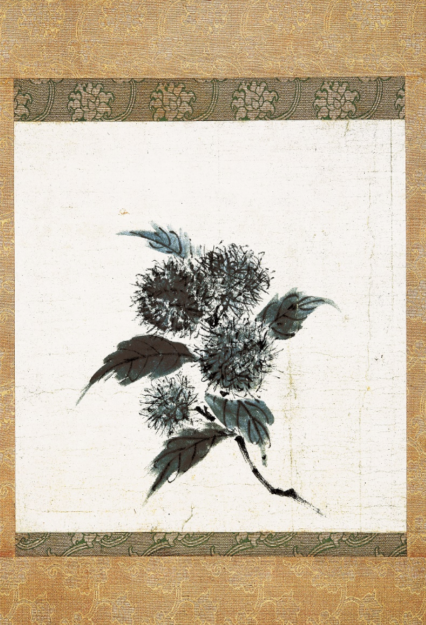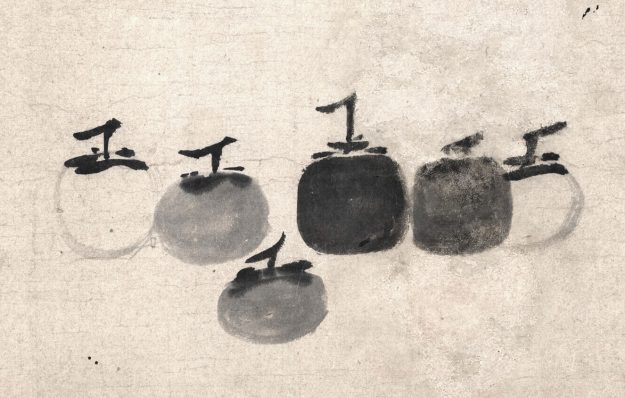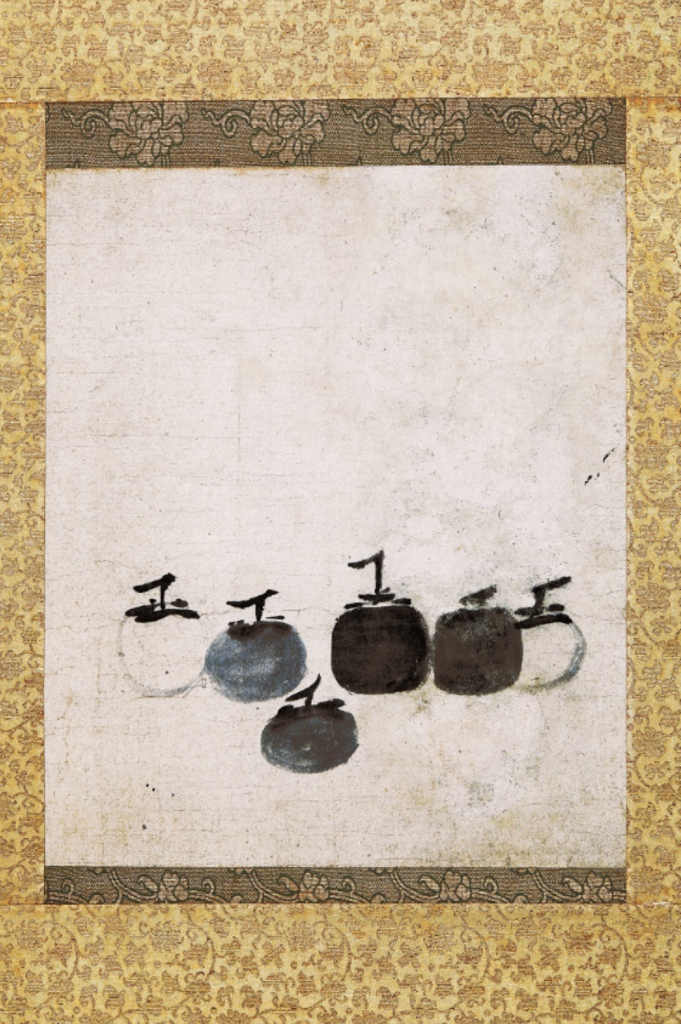In the spring of 2017, Kobori Geppo, the abbot of Daitokuji Ryokoin, a Buddhist temple in Kyoto, Japan, traveled to San Francisco for a conference. During the trip, he and his followers paid a visit to the city’s Asian Art Museum, which at the time was preparing two different exhibits on Buddhist art: “Flower Power,” about the symbolism of plants in contemporary paintings, sculptures, and pop art; and “A Billion Buddhas,” about the portrayal of the Buddha in Tibetan culture.
Charmed by the museum’s warm welcome, the abbot made its curators an offer they could have neither foreseen nor refused. Back in Japan, inside the heavily guarded storage facility of the Kyoto National Museum, Daitokuji Temple kept a painting by the legendary Chinese artist and monk Mu Qi. Known as Six Persimmons, this abstract still life of autumn fruit had long been regarded as the Mona Lisa of Zen Buddhism, its enlightened composition pointing observers in the direction of nirvana. Made during the 13th century, it was famous for its beauty as well as its inaccessibility, having never been displayed outside of Japan, until now.
“The abbot chose us,” Laura Allen, the Asian Art Museum’s chief curator of Japanese art, clarifies over Zoom. “We are very honored that he thought of us as the right venue,” adds assistant curator Yuki Morishima, who together with Allen turned Daitokuji’s proposal into an exhibit titled “The Heart of Zen.” Running from November 17, 2023 until December 31, it will first show Six Persimmons, followed by another, slightly less iconic but equally hypnotizing still life Chestnuts. In addition to outlining Mu Qi’s global reception, the once-in-a-lifetime exhibit will answer an initially bewildering question: whether his paintings are truly the spiritual masterpieces we think they are.

Mu Qi—also spelled Muqi or Muxi, and sometimes called Fachang—was a Chan Buddhist monk who lived during the final days of the Southern Song dynasty. Largely ignored by his home country—one Chinese text from 1365 refers to his work as “coarse, ugly, and lacking in ancient techniques”—his unconventionally atmospheric brushwork and preference for seemingly mundane subjects acquired a devoted following in Japan, where they would influence painting for centuries to come.
Mu Qi’s rise in popularity is understandable, as even today his deceptively simplistic paintings possess a calming aura that cannot be easily replicated. In the case of Persimmons, this effect derives from the image’s seemingly spontaneous but actually quite meticulous construction. Foregoing the realistic detail that defines many a Western still life, the monk allows his fruits to float inside an empty space. By creating contrast between size and color, he further manages to produce a composition that is diverse yet unified, energetic but balanced.
The longer you stare at the painting, the more its design appears to illustrate concepts central to Zen Buddhism, including groundlessness. Persimmons are a powerful metaphor for human mortality. Harvested during the fall—a season of death and dying—the bittersweet-tasting fruit (described as a combination of mango, cinnamon, and roasted pepper) ripens just before it begins to rot, and can be dried and preserved to make candy.
Rendering the fruits’ exteriors with single, circular strokes, Mu Qi evidently wanted to evoke the ensō, a Buddhist symbol of strength, connectedness, letting go of expectations, and embracing imperfection in yourself and others. Read from left to right and right to left, the arrangement of the persimmons also seems to suggest the cycle of life, with small, white fruits giving way to bigger, darker ones. As Chinese art historian Friedrich Zettl observes in his blog:
“We enter the world with nothing as if coming from the light. In our early years, we are innocent and inexperienced (persimmon #2 from left), but full of vitality. During adolescence, we start at the very bottom (#3), looking up to our superiors. It’s worth noting that the perspective of #3 is from above, emphasizing our inferiority. We reach the zenith of our life and work (#4) and become superiors ourselves. From then on, it’s a downhill journey until we leave this life with nothing.”
Zettl goes on to note that Mu Qi chose a subject that had not yet been depicted in Chinese painting. Free of the cultural connotations that tied down paintings of bamboo and blossoms, Six Persimmons could not be scrutinized for hidden meaning, observed only for what it was.

And yet, when approached from a Buddhist perspective, even this explicit lack of symbolism becomes, in a way, highly symbolic. Just as Zen Buddhists favor meditation over the study of scripture and sutra, so does Mu Qi’s still life depict an object without imposing a narrative.
The still life also evokes what Zen practitioners refer to as nonconceptual understanding. “Contrast Muqi’s Persimmons with Song paintings that make literary, poetic, historic references,” another Chinese art historian, the late James Cahill, once explained in a lecture at the University of California, Berkeley. “In Zen, viewer and viewed do not stand apart, but occupy a continuum. Chan artists cut though the overlays of style and literary references to present direct, unmediated image without intrusion of styles.”
For a long time, Cahill’s interpretation of the painting—as an unrivaled illustration of Zen teachings—reigned supreme, so much so that, to this day, many of its admirers are shocked to learn about its original reception in feudal Japan. Although certainly revered, none of this reverence was directed toward its spiritual subtext. Rather, Persimmons was appreciated for its aesthetic and aesthetic alone. Its first Japanese owners, the well-to-do Tsuda family, used it as a decoration for their tea ceremonies, held in a period when the beverage started to be accompanied by fruits and nuts. Seldom looked at directly, the still life remained in the background, contributing to the mood instead of the conversation.
Persimmons arrived in Japan when Zen Buddhism was still restricted to monasteries, exerting little influence on wider Japanese culture. The painting became associated with Zen only once its audience had become acquainted with the movement as well. In a 2021 study published in the Korean Journal of Art History, art historian Heeyeun Kang of Seoul National University argues that the Japanese upper class began to promote Persimmons as the poster child of Zen Buddhism as part of a larger project to “emphasize Zen as their [national] identity.”
When Zen started catching on in the West, too, critic Okakura Tenshin proclaimed that Zen culture, forgotten in its native China, had become inextricably Japanese in character. Fellow critic Aimi Kōu used Okakura’s sentiment to essentially rewrite their country’s cultural history, starting with a fateful reconsideration of Six Persimmons. “Only the artist with a thorough experience of Zen could have achieved such sureness of effect with such apparently simple means,” echoed Yasuichi Awakawa’s decisively titled book Zen Painting, published in 1970. In Persimmons, the philosopher Hisamatsu Shin’ichi asserted, the true Buddha appeared as the “Formless Self,” awakened to existence’s inherent emptiness.
By the early 1900s, Mu Qi’s painting had become such an unequivocal emblem of Japan that the government declared it an “Important Cultural Property” despite its foreign origin.
Japan’s Zen-centered reappraisal of Persimmons was blindly accepted by Western scholars like Cahill, who himself was one of the most prominent sinologists of his time. Beating him to it, though, was the equally influential orientalist, Arthur Waley, whose 1922 essay “Zen Buddhism, and Its Relationship to the Arts” described the still life as “passion (…) congealed into a stupendous calm.” Providing contested support through the writings of a 12th-century monk named Dogen, Swiss translator Helmut Brinker later referred to Mu Qi’s fruits as “ciphers of transcendence.”
Studying Japan’s treatment of Mu Qi not only prevents us from drawing erroneous conclusions from his work but also helps us better understand the role of art in Zen. In reality, notes one of the didactic texts at the “Heart of Zen” exhibit, paintings like Persimmons “live side by side at Zen temples with myriad visual objects: colorful priest portraits, traditional Buddhist icons, incense burners, tea wares, and ecclesiastical robes among them. Encountering them together, we can honor the heterogeneous nature of monastic experience, as well as the multiple lives and reception of objects over time.”
But even though Six Persimmons wasn’t initially received as a Buddhist masterpiece, that doesn’t mean it cannot resonate with the viewer’s own spiritual journey. Having seen the painting only in the form of reproductions, Morishima, the assistant curator of “Heart of Zen,” readily recalls her excitement when coming face-to-face with the real deal. Staring at the paths of individual brushstrokes, unbroken and confident, and sensing the weight of the empty space around the fruits, one simply cannot help but feel a certain calm. Maybe it’s a placebo effect, brought on by the painting’s inescapable reputation. Maybe it’s real and authentic, and, as such, one the reasons the Tsuda family kept it around for so long.
Thank you for subscribing to Tricycle! As a nonprofit, we depend on readers like you to keep Buddhist teachings and practices widely available.
